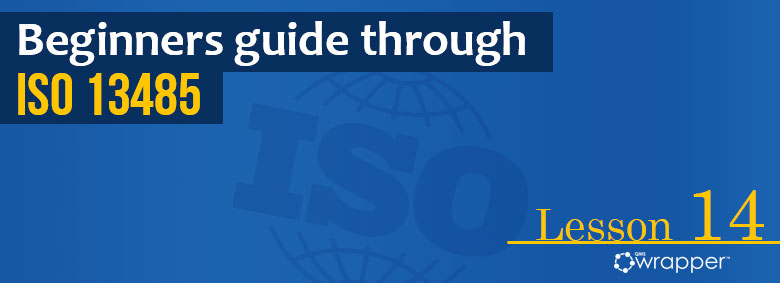
Medical device Production and service provision in ISO 13485 - Lesson 14
ISO 13485 standard intends to cover a wide range of manufacturing, therefore, it’s a bit generalized when it comes to defining applicable requirements and service provision processes.
This section of the standard might be confusing for many, but we will try to divide it down into simple and understandable pieces. Exactly 11 sections.
Control of production and service of provision
Control means your medical device company has to plan, carry out, monitor, and control the production. It is to ensure your medical device meets the set of specifications and that you have the necessary processes and environment to support its realization. It’s recommended to apply a risk-based approach towards control of production.
Control is expected to be achieved through documenting procedures and methods. The qualification of infrastructure is also taken into consideration. For example, a situation where the infrastructure can affect the conformity of your device. Depending on the production process, your medical device company has to implement monitoring and measuring activities too. Plus, to identify requirements for labeling and packaging.
And once your medical device is manufactured, you need to define and perform activities for product release, delivery, and post-delivery, if the nature of the product requires it.
Cleanliness of product
In case your product requires a certain level of cleanliness, you need to document that requirement too. It is required to have a detailed procedure that indicated employees’ behavior and operations with materials, products, parts, or components. The cleaning process has to be verified, validated, and monitored.
Installation activities
In case your medical device requires a certain type of installation, then you need to include acceptance criteria and provisions to verify correct installation. In case when the installation activities are meant to be outsourced you need to provide documented information for the installation and verification to the outsourced partner. The purpose is to ensure the medical device will function properly in terms of functionality, performance, safety, and intended use.
Servicing activities
You have to define servicing activities if they are required too. That means any requirements, specifications, and procedures must be recorded and become part of your medical device file. The point is to define the type, interval, intensity, or complexity of provided service activities, and to set up roles and responsibilities.
Particular requirements for sterile medical devices
If your medical device requires to be sterilized, you will define it during the design and development process, and ISO 13485 defines that sterilization process parameters should be defined.
All sterilization records have to be traceable to each production batch of your medical device production.
Validation of processes for production and service provision
This is only used in case your medical device company is unable to verify the output of a process later on. When this is the case, you validate your process to make sure it achieves the planned results and this is, of course, very specific to the processes in the company.
Particular requirements for validation of processes for sterilization and sterile barrier systems
Validation of sterilization processes – you have to develop a procedure to address the validation of sterilization processes. Validation will be necessary if there is a change or addition to a process or a product.
Validation of sterile barrier system – A sterile barrier system is a system that includes minimum adequate barriers to protect medical devices from microorganism contamination.
Identification and traceability
And yet again, you need to document the procedure for identification and traceability to identify the product throughout product realization. Things like materials, components, sub-assemblies, inventory, work in process, finished goods have to be identified by your Med-Dev company with the prime objective to eliminate mixing together the products, parts, or material with different status at all stages of the material flow.
Traceability is giving you valuable information about your product in the event of any relevant quality events – it traces the history, location, or status by recorded identification.
Customer property
Customer's property is good of a different kind, that is delivered to the manufacturer by the customer for further processing, for use during the realization process. So the owner is the customer.
The point is to set the processes on how to identify, verify, safeguard, and protect certain customer property. You need to control it from unintended use. Maintain records of such events is an absolute must.
Preservation of product
Preserving of product is one of the requirements of the ISO 13485. Protecting medical devices during processing, storage, handling, and distribution are falling under this section.
All factors that can harm the medical device should be identified.
To summarize
Be aware that that any requirement in the medical device realization section of the standard might be excluded from a quality management system if they do not apply to your business.
Knowing your medical device and what is required for it is the first step in assuring successful provision activities for creating and delivering the product or service.
Using qmsWrapper’s Custom form feature it is easy to build the template for recording any of the above-mentioned activities – servicing, installation, sterilization, etc.
It will be obvious that who and when performed it, and record will be maintained in the system. It can be exported as well!
PREVIOUS LESSON NEXT LESSON ALL LESSONS
ISO 13485 implementation: Mandatory documents and records
Validation efforts
Gap analysis in QMS